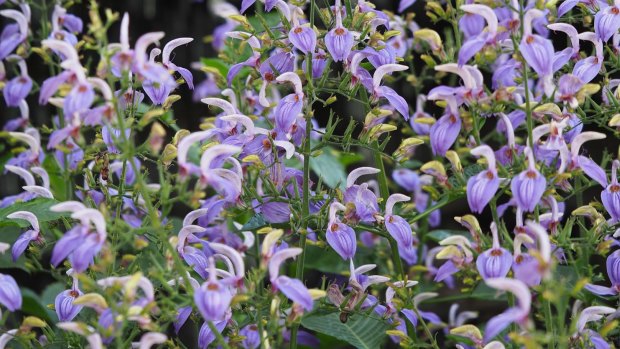This was published 6 years ago
Gardening: The brilliant beauty of Brillantaisia
Claw-shaped purple flowers top a lush, tall shrub with crinkled leaves and an enthusiastic growing habit.
By Robin Powell
Being a plant collector in the 18th century was dangerous work. Take the case of Ambroise Marie Francois Joseph Palisot, Baron of Beauvois, who endured the kind of vicissitudes that are only fun if you are watching Jason Bourne or James Bond survive them. Not that the botanist baron was hero material. He was a loud and proud supporter of slavery who quit France as the Revolution took hold to establish a colony of like-minded types in Africa. So perhaps he had what was coming.
The British invaded his colony, yellow fever nearly killed him, his house and all his botanical collections were burnt down by rioting slaves in Haiti, several robberies left him penniless and he was forced to make ends meet working in a circus in the USA. Meanwhile he collected many botanical specimens, but after finally having his French citizenship restored, his ship was wrecked off the coast of Nova Scotia as he headed homewards and he lost the lot.

Brillantaisia ulugurica.Credit: Robin Powell
I only know about the tribulations of Palisot de Beauvois because one of the plants he collected in Africa and did manage to get back to France unharmed, is growing in my garden and looking stunning. It's Brillantaisia ulugurica and has big upright heads of claw-shaped purple flowers that look a bit like a salvia on protein supplements. The flowers top a lush, tall shrub with handsome, big, crinkled and pleated leaves.
It's a brilliant plant, so it's tempting to misspell it as brilliantasia, and to think that's what Beauvois meant to call it. In fact it's named for a gardener-botanist who accompanied the baron to Africa, and for the Uluguru mountains of Tanzania where he found it.
In the garden brillantaisia likes a sunny or partly shaded spot, though if in too much shade it will flower little and grow large and lanky towards the light. Protection from strong winds that would tear those lovely leaves is a good idea and it needs enough room to reach about three metres tall and a couple wide. It's good against a fence at the back of a border where it can screen the neighbours without screening the sky. It looks good with salvias and the lavender-flowered, grey-leafed Tibouchina hetereomalla. Right now I'm loving it with the red and purple flowers of pavonia.
Brillantaisia will flower from late spring until the end of autumn, especially if the finished flower spikes are removed. While you have the secateurs out, take a few cuttings, which strike easily in the warm months, to share with friends. That's how I have it, given it by a friend whose garden turned out to be too small for its enthusiastic habits. If you don't have a friend who has it, try the Growing Friends at the Royal Botanic Gardens.